How to Distinguish Real Cheese From Fake Cheese
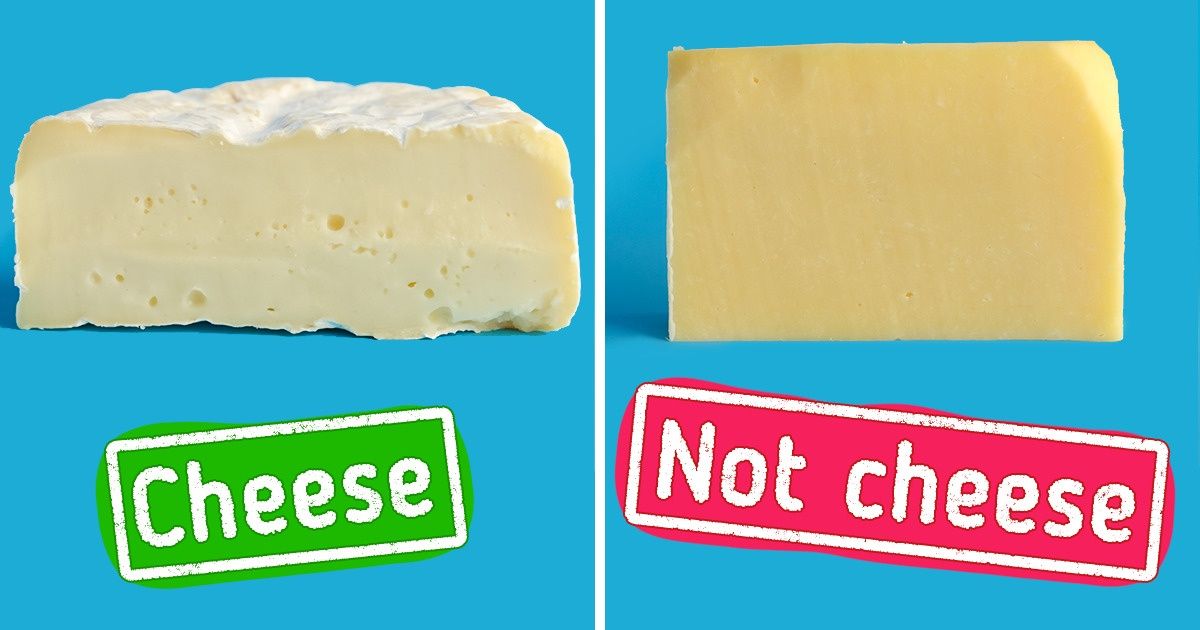
Cheese is a popular product loved by many. Nowadays, you can find a wide variety of cheeses and cheese products on store shelves. But you need to understand that they are not the same thing.
5-Minute Crafts would like to tell you about how to distinguish real cheese from fake cheese.
What cheese is made from
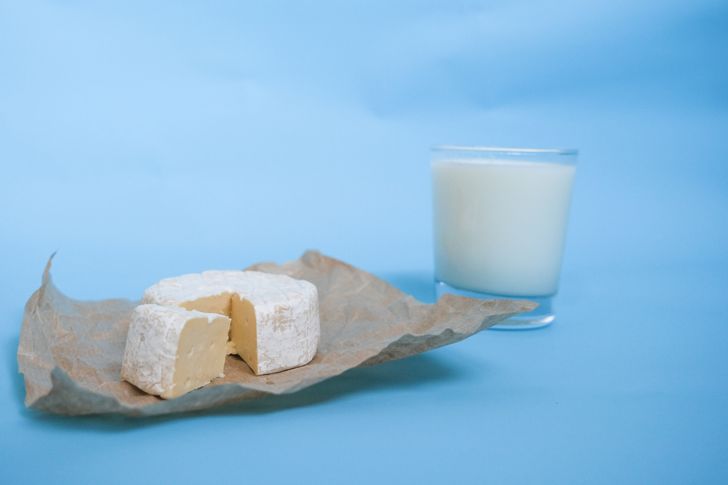
Cheese is made from the milk of cows, sheep, goats, horses, or buffaloes. Different types of cheese differ not only in the type of milk used in them, but also in the way they are processed, as well as the enzymes, bacteria, or mold used.
The cheese’s taste and texture depends on the type of milk, the aging time, and even the region where it’s produced. Cheese can be aged or not.
The main ingredients of cheese:
- milk
- salt
- rennet
- bacteria
It is the enzymes that cause the milk to separate into curd and whey. The curds are the basis of all real cheeses: from cottage cheese to Parmigiano Reggiano to Gorgonzola.
The benefits of cheese
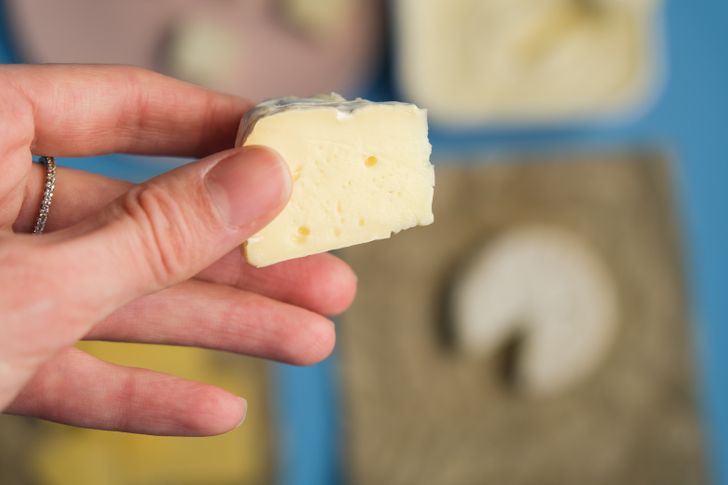
Cheeses contain the following healthy elements:
- calcium
- protein
- vitamin B12
- vitamin A
- vitamin K2
- phosphorus
- conjugated linoleic acid (CLA)
Many people with lactose intolerance can safely eat certain types of cheese. The fact is that some real cheeses are low in lactose, a natural sugar which is found in milk. These cheeses include cheddar, mozzarella, and Swiss cheese. A lot of lactose is usually found in creamy cheeses, like ricotta, cottage cheese, and cream cheese.
Natural cheeses are generally gluten-free. But check the description on the package to make sure.
Types of cheese
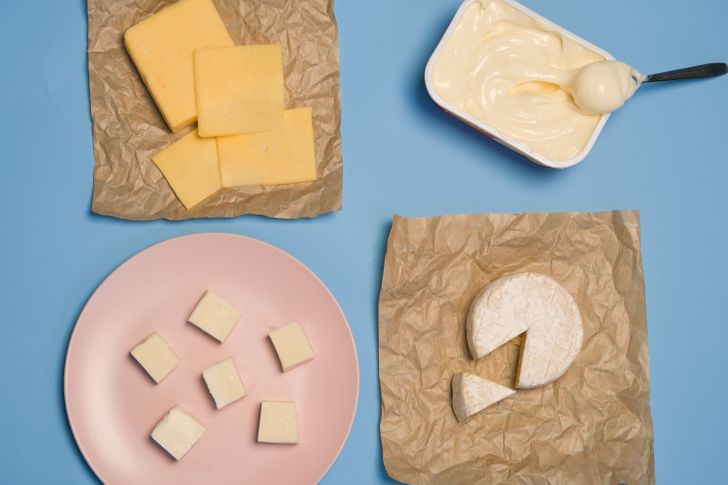
- Fresh or unripened cheese is not aged at all. Its taste and texture depend on the amount of salt and whey used during the manufacturing process. These cheeses include creamy French chevre and mild queso fresco.
- Bloomy rind or soft-ripened cheese is aged from the outside in, creating a soft and runny interior held in by a thin layer of bloomy rind. They use a very particular strain of mold called Penicillium camemberti during the aging process. It converts the fats in the cheese into aromatic compounds called ketones. This is why soft-ripened cheeses like Brie and Camembert have a characteristic nutty-mushroom flavor.
- Semi-soft cheese is aged for only a couple of months. The water content in it should be between 36% and 45%. It’s distinguished by the delicate taste and moist, yielding texture. Note that this cheese can’t be grated, it’s too soft for that. Semi-soft cheeses include Havarti and Limburger.
- Washed-rind cheese ripens in the same way as bloomy rind cheese — from the outside in. To prevent white mold from developing, the rind is often washed. They do it with sea water, wine, beer, and even liquor. This process removes the mold, while at the same time encouraging the growth of a sticky orange bacteria called Brevibacterium linens. These bacteria give the cheese a peculiar pungent smell. Washed-rind cheeses include the famous Limburger and Taleggio.
- Semi-hard cheese. Most of the cheeses produced are semi-hard. Their taste depends on the bacteria used to create the starter culture, and the aging time. The longer the cheese aging is, the harder and richer it tastes. Semi-hard cheeses include Gouda, Edam, and Cheddar.
- Blue cheese. If soft-ripened cheeses are treated with mold on the outside, blue cheeses are injected with mold internally. This is how veins are created, the color of which can vary from blue-green to black. During ripening, the cheese rounds are punctured with thin needles over the entire surface. This is done because mold needs oxygen for development. This is what gives the final product its characteristic creamy crumbly texture. These cheeses include Gorgonzola and Roquefort.
- Hard cheese. This category includes cheeses with a very low moisture content. They are so dry and hard that they can crumble. The aging of hard cheeses lasts for a long time — 2 to 3 years. Due to their texture, they can stand up well to a grater and are often used in cooking. These cheeses include Parmigiano Reggiano and Gruyère.
- Pasta filata. This is a stretched curd cheese that is well-known in Italy. It’s soaked in hot water and then stretched by hand until it achieves its characteristic fibrous bouncy texture. Pasta filata is not aged, so it can be classified as fresh cheese, but thanks to its method of preparation, it deserved a classification of its own. Classic examples of this cheese include Mozzarella and Burrata.
Cheese and cheese products
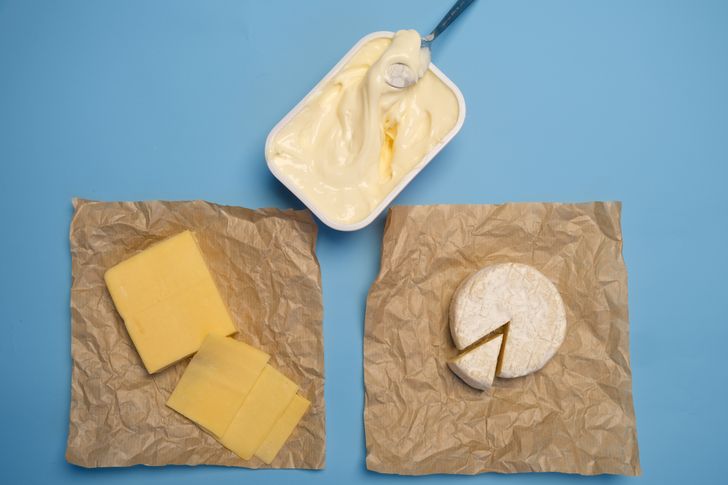
You can find a wide variety of cheeses and cheese products in modern shops. All of them can be divided into several categories:
- Cheese is the natural product that we talked about above.
- Pasteurized processed cheese. It’s manufactured by heating one or more natural cheeses together.
- Cheese products. Cheese products contain not only milk, enzymes, and bacteria but also stabilizers, emulsifiers, vegetable oil, salt, sugar, food coloring, and so on.
How to distinguish natural cheese from a cheese product
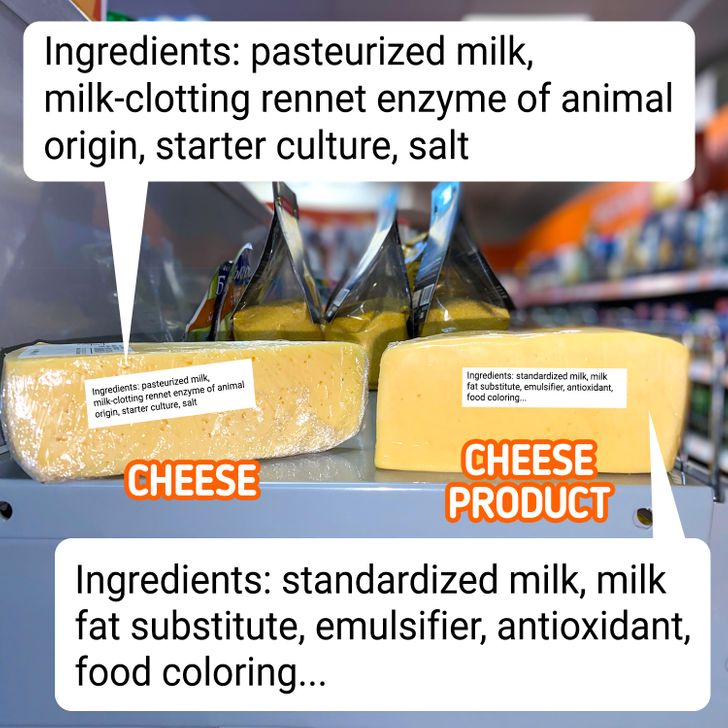
Some types of natural cheese can be quite expensive because it takes about 10 liters of milk to make 1 kilogram of cheese. Therefore, cheaper cheese products can be found in supermarkets.
Many people wonder how to distinguish natural cheese from the wide variety of cheese products. Follow these rules:
- Look at the price.
Natural cheese will cost more than a cheese product. - Read the label.
Always read the packaging carefully. If you see the words “cheese product” on it, it’s not real cheese. - Study the ingredients.
We have already written that natural cheese always has a simple and short list of ingredients. Cheese products contain emulsifiers, preservatives, and other unwanted additives. - Check the ingredients for the presence of milk fat substitutes.
They are only used in cheese analogues and various cheese products.
How to choose cheese in a cheese shop
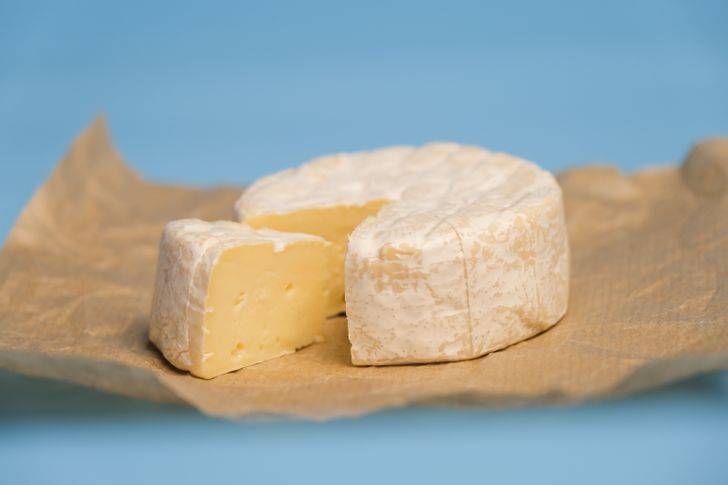
- Pick a good cheese shop. If you do decide to visit a cheese boutique, let it be really reputable.
- Turn to a sales assistant for help. As a rule, these stores employ people who know a lot about cheeses.
- Decide on the texture. Think about what kind of cheese you want to buy: soft, hard, or stretched.
- Try it. Pick a few cheeses and ask the sales assistant to let you taste them. It will be easier for you to make a choice this way.
- Pay attention to the aftertaste. The taste of good cheese will stay with you for a long time.
- Try raw milk cheese. Cheeses are usually made from either raw, or pasteurized milk. It’s believed that a product made from unpasteurized milk tastes more natural.
- Check to see where the cheese is made. Some cheeses are produced only in certain regions. For example, Single Gloucester can only be made on the farms of Gloucestershire (UK).
- Don’t be afraid to try something new.
How to choose good cheese in a regular store
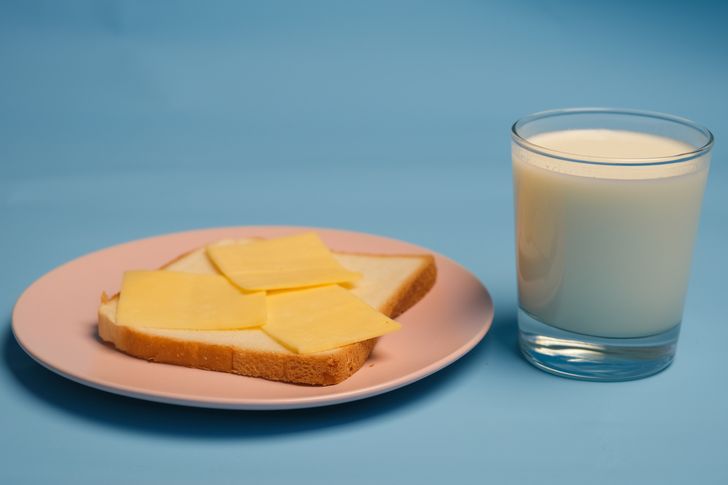
Of course, the best place to buy cheese is a cheese shop or boutique. In these places, you can often taste cheeses to make a choice. But what if you have to buy cheese in a regular store?
- Pay attention to the price. Generally, good cheese can’t be cheap.
- Take a close look at the cheese. It should be free of cracks and mold, unless it is special mold. The color of the cheese should not be changed. If the cheese is discolored, it means that it was stored incorrectly or it’s simply stale.
- Remember, aged cheese should not look oily or dry. Soft fresh cheese should not flake, and delicate mold-ripened cheese, such as Camembert, should not be flattened or oozing in the package.
- Check the date of packaging and the expiration date.
- If possible, ask the sales assistant to cut you a fresh piece. The fact is that after a couple of days in cling film, cheese can acquire a plastic taste.
- Don’t buy a big piece of cheese. It’s better to only get as much as you can consume within a few days.
How to store cheese
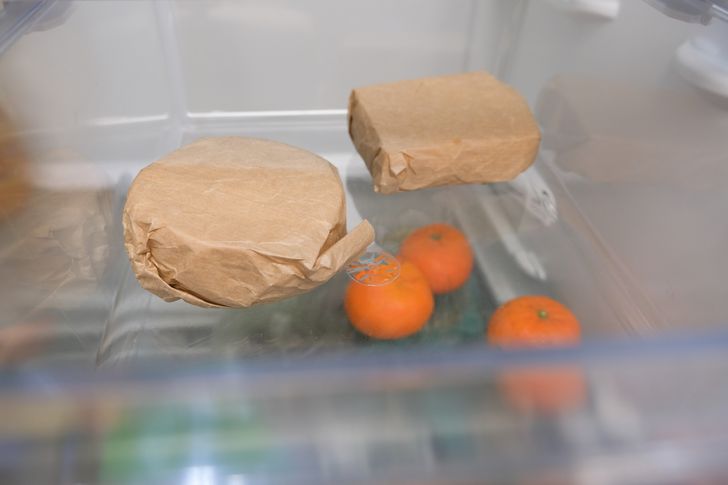
Don’t store cheese in the refrigerator door. Put it on the shelf close to the back wall — it’s cooler there. Opened hard cheeses usually last approximately for 2 to 4 months, while soft cheeses last for much less time in the fridge. Usually, soft curd cheeses can be stored in the refrigerator for no more than 2 weeks after opening. Hard cheeses can be frozen, however, they can become more crumbly after defrosting. These cheeses can be stored in the freezer for up to 7 months, if they are tightly sealed from oxygen.
Cheese is best stored in special cheese paper, but parchment or wax paper can be used instead. If you store cheese in plastic wrap, it may acquire a chemical aftertaste.
By the way, it’s not recommended to eat cheese immediately after you’ve taken it out of the refrigerator. Leave it at room temperature for an hour. During this time, the butterfat in the cheese will settle, allowing you to enjoy the full range of flavors and textures. And to make sure the cheese stays fresh, leave it in the wax paper until the last possible moment.